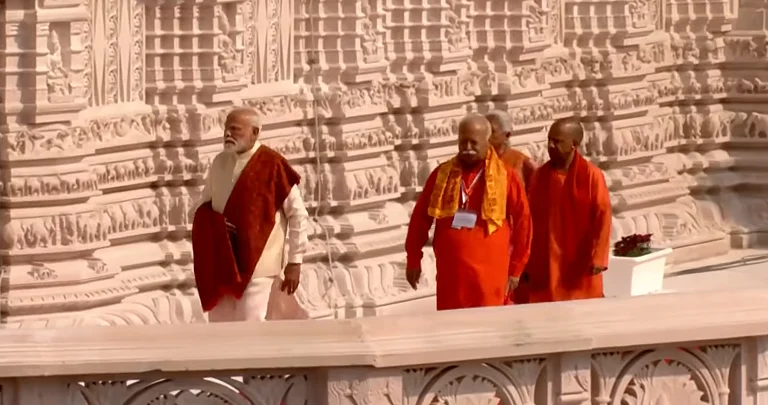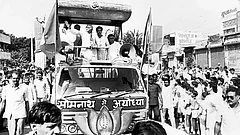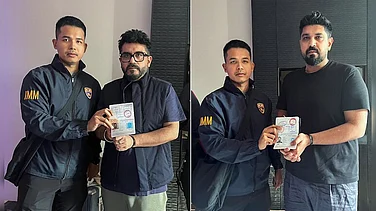‘‘Do you have an idol of Ram in your prayer room?” asks one of the several saffron-clad volunteers who have been knocking on doors in a South Bengaluru pocket.
Such groups of five to ten saffron-clad ‘volunteers’, armed with a pamphlet and akshate (turmeric-laced rice) and in their hands, have been regularly fielding this leading question after knocking on doors of homes in the capital and other parts of the state.
Their follow-up request is invariably an imploration to pray in the name of Lord Ram on January 22, the day when an idol dedicated to the deity is scheduled to be installed at the newly constructed Ram temple at Ayodhya.
Sometimes, requests made by such groups even tend to cross the boundaries of personal space, especially when they invite themselves into homes to see the idol with their own eyes.
For Charan Teja (name changed), a resident of South Bengaluru for almost 60 years, this ‘outreach campaign’ ahead of the consecration ceremony of the new Ram Temple in Ayodhya came as a surprise. Neither did he worship Rama nor has he witnessed a door-to-door outreach effort on religious lines at such a scale previously in the state.
The fervour and frenzy of the installation of the Ram idol at Ayodhya on January 22 has also crossed over from Karnataka, considered the gateway to ruling the South for the ruling Bharatiya Janata Party, to Kerala, the country’s southernmost sentinel and a state where the BJP has failed to make any electoral dent.
Malayali playback sensation K S Chithra is revered as the ‘Nightingale of Kerala’ with an impressive catalogue of over 25,000 songs across various Indian languages.
But her recent shoutout on social media, calling for the collective observance of the pooja and lighting of lamps at homes on the occasion of the inauguration of the Ram temple in Ayodhya on January 22, has attracted critical attention.
Known more for her musical prowess and her consistent distancing from political discourse during public engagements, Chithra’s video supporting the Ayodhya event stirred controversy, with critics arguing that the ceremony at the Ram temple endorsed by Chitra inadvertently normalised the “injustice” to Indian Muslims caused by the demolition of the Babri Masjid.
“The highlight is the ‘innocence’ in conveniently forgetting the fact that the temple was built by demolishing the mosque. More K S Chithras will disclose their real faces soon,” rebutted Sooraj Santhosh, a young Malayali playback singer.
The popular backlash saw another popular singer, Venugopal, issue an apology on Chithra’s behalf, imploring forgiveness and attributing her action to her limited engagement with politics.
Even though the BJP has never won a seat in Kerala’s state legislative assembly, the trend of ‘Hinduisation’ in the public sphere reveals an evident footprint. “The cultural landscape of Kerala has experienced a slow-burning impact from the Ram Janmabhoomi episode. We can see a surge in Malayalam movies addressing the perceived sufferings of the upper-caste Hindu population, attributing their plight to reservations for backward communities,” says Sreejith Divakaran, a script writer and journalist who was a student at the time. Later, he joined Mathrubhumi in Delhi and wrote several reports from Ayodhya.
The Ram Janmabhoomi movement appears to have legitimised and accelerated the manifestation of Hindutva in God’s Own Country’s cinema, with even former Hindu Mahasabha leader late V D Savarkar being glorified in Kalapani, a 1996 film starring superstar Mohanlal. The region’s cinema has also consistently portrayed Muslims in bad light as villains.
The slow-burn of saffronisation, as exemplified by the Ram Janmabhoomi movement, has, however, not found resonance in the electoral landscape of Kerala, where the power dynamics have consistently oscillated between the Left Democratic Front (LDF) and the United Democratic Front (UDF).
Between 1989 and 1996, the BJP’s Kerala vote share plateaued at around five per cent, despite saffronisation efforts like L K Advani’s rath yatra and Babri Masjid demolition. In contrast to North India, Kerala and Tamil Nadu witnessed limited electoral impact for the BJP during this period.

In Tamil Nadu, the BJP’s electoral sway is minimal, contrasting with its status in Kerala. Despite persistent efforts by ‘Hindu Munnani’ in 1996, the BJP only garnered three per cent of the votes. The party’s electoral growth seems stagnant, holding a 3.66 per cent vote share in the 2019 Parliament Election despite aligning with AIADMK, a regional powerhouse.
However, the growth of saffron politics cannot be measured by vote share alone. Parallel to the Ram Janmabhoomi movement, saffron groups in Tamil Nadu organised Ganesha Chathurthi processions, leading to incidents of communal tension. In 1983, ‘Hindu Munnani’ and RSS installed a Ganesha idol near a Chennai temple. By 1990, large processions had triggered clashes near the Ice House mosque in Triplicane. These clashes have been described as a “turning point” by scholar C J Muller in the Economic and Political Weekly (May 2001).
Even Though The BJP Has Never Won A Seat In Kerala’s State Legislative Assembly, The Trend Of ‘Hinduisation’ In The Public Sphere Reveals An Evident Footprint.
Muller notes that Hindu Munnani, formed in the early 1980s, is Tamil Nadu’s key Hindu nationalist group alongside the RSS. Linked closely to the BJP, it plays a politico-religious role comparable to the Vishwa Hindu Parishad in the north, despite the VHP’s own presence in the state.
Like Vinayaka Chathurthi, saffron organisations in Kerala also celebrated Vijayadashami and organised processions on the day of Srikrishna Jayanthi.
“The Ram Janmabhoomi movement may not have created immediate waves in Kerala, but its subtle influence has permeated through various facets of society, leaving a lasting impact on the political, cultural and emotional fabric. Despite not causing an immediate ‘ripple effect’, the movement has steadily shaped the perspectives of a significant section of the population. This is evident in the heightened participation of people in festival spectacles like Vijayadashami, a major celebration of the ‘victory of Lord Ram,’ predominantly organised by the BJP and RSS,” says P K Yasser Arafath, a Malayali historian and Fulbright research fellow at the University of Pennsylvania.
Yasser Arafath notes Lord Rama’s heightened ritual significance in Kerala since the 1980s, strengthened by the televised Ramayana serial in 1987, a cultural phenomenon that quickly became one of the most-watched TV series in the state. This followed the Vishala Hindu Sammelan’s 1982 call to observe the Ramayana month. “The Ram Janmabhoomi movement facilitated the emergence of a novel demographic—the Sangh supporters untrained in Shakhas,” articulated P N. Gopikrishnan, author of The Story of Hindutva Politics.
According to Gopikrishnan, the materialisation of Hindutva aspirations has acquired social legitimacy, shedding the stigma that once attached to such sentiments in Kerala society, known for its progressive left-liberal political orientation.
Even as the saffron right continues to flounder electorally in Kerala, the ideology’s rise in Karnataka following the Ram Janmabhoomi movement appears to have paid off.
Historically, Karnataka has been the BJP’s gateway to South India, garnering the party’s highest electoral gains among the five southern states. In the 1990s, even under Congress rule, the RSS wielded considerable influence in Karnataka during the Ram Janmabhoomi movement. While immediate gains were limited, these efforts significantly contributed in the BJP’s eventual ascendance to power in the state in 2008, according to Shivasundar, a senior journalist and activist.
A noteworthy episode indicative of such efforts was the dispute at the shrine in Baba Budangiri, located in Chikkmagaluru district in Karnataka, located around 1,900 kilometres southwards of Ayodhya.
Pro-Hindu groups orchestrated rath yatras in a bid to assert ownership of the shrine solely for Hindus. The nomenclature of the shrine itself, ‘Shri Guru Dattatreya Swamy Baba Budan Dargah’ underscores its syncretic identity. The revered site honours Guru Dattatreya, a Hindu deity believed to embody the Trimurti—Shiva, Vishnu and Brahma as a unified entity, alongside Baba Budan, a 16th-century Sufi saint credited with introducing the coffee plant to India and Dada Hayat, an 11th-century Sufi saint. However, during the build-up to the demolition of the Babri and as the Ram Janmabhoomi movement peaked, factions advocating the Hindutva mobilised to transform the dargah into a Dattatreya temple. With clear battle-lines drawn, Karnataka was poised to replicate Gujarat’s model, envisioning the transformation of Baba Budan Dargah into another Ayodhya, according to Shivasundar.
“Despite the governance being under a Congress-led administration led by C M Sarekoppa Gangarappa during that time, it was perceived as a triumph for the right-wing,” he asserts.
Subsequent to such incidents, right-wing entities like the Bajrang Dal orchestrated shobha yatras and Datta Mala pilgrimages, mirroring the Ayodhya ‘toolkit’. Despite a Supreme Court directive limiting actions to pre-1975 norms, the Karnataka High Court, in 2022, allowed Hindu rituals at the Baba Budan dargah after a 21-year hiatus.
While the shrine traditionally accommodated both Hindu and Muslim practices, the new order mandates a Hindu priest to conduct the affairs, “which was one of the conditions laid down by pro-Hindu groups in order to ‘liberate’ the site and reclaim it from alleged ‘Islamisation’,” says Aravind Mallgatti, a prominent Dalit poet and Kannada writer.
In the early 1990s, the rath yatra spearheaded by L K Advani, which originated from Somnath in Gujarat and journeyed to Ayodhya, traversed through north Karnataka. A substantial contingent of volunteers from the state actively participated in this yatra, with some transporting bricks from their localities to Ayodhya in the hope that these bricks would be used in the actual construction of the Ram temple. Several local yatras were also organised, which often escalated communal tension.
“The atmosphere was communally volatile. Several shops were set on fire in Ullal—a major junction in Mangalore. Both Hindu and Muslim shops were burned. Section 144 was in force. The agitators set fire to tyres on the roads to prevent vehicles from moving,” says Mallgatti, recalling the happenings in 1992 in Mangalore.
Although the situation post Babri Masjid demolition in South India did not take the same communal tone like it did in the North, Mallagatti contends that there was a notable trend of conducting oral and written surveys throughout Karnataka, aiming to transform various religious sites into temples. This phenomenon bolstered the mobilisation of Hindutva forces.
Prior to the rath yatra, the BJP secured only 4.14 per cent of votes in Karnataka’s 1989 elections. In contrast, Congress dominated with 43.76 per cent, and Janata Dal followed with 27.08 per cent. By 1994, the BJP had surged, quadrupling its vote share to 16.99 per cent. Concurrently, Congress’s share declined to 26.95 per cent, while Janata Dal increased to 33.54 per cent. The electoral landscape shifted significantly, reflecting the BJP’s rise and altering the political dynamics in Karnataka during this period.
Though the BJP lost power in Karnataka in the 2023 assembly election, signifying yet another political shift, the party managed to sustain the 38 per cent vote share it had clocked in the 2018 polls. In the Lok Sabha elections, the BJP has demonstrated a consistent upward trajectory. Shivasundar emphasises that despite the Ram Mandir narrative finding less resonance in the South, the BJP has persistently accrued electoral gains at the national level. He underscores that the ongoing campaign leading to the inauguration of Ram temple is poised to bolster the BJP’s influence in the southern states.
“The Fervour Surrounding The Ram Temple Highlights How Effectively The Ram Janmabhoomi Movement Has Influenced A Large Section Of The Populace Since The 1990s”.
“The fervour surrounding the newly built Ram temple in Ayodhya further highlights how effectively the Ram Janmabhoomi movement has engaged and influenced a large section of the populace since the 1990s,” says Arafath.
Beyond electoral politics, Arafath highlights a broader impact. Many, including Southern filmmakers, singers and writers, are attracted to the cultural and emotional underpinnings of the movement, regardless of their stance, opposition, or indifference towards the BJP during elections, indicating a social ferment in the process.
MORE FROM THIS ISSUE
Shahina K K and Anisha Reddy
(This appeared in the print as ''The Slow-Burning South')
































